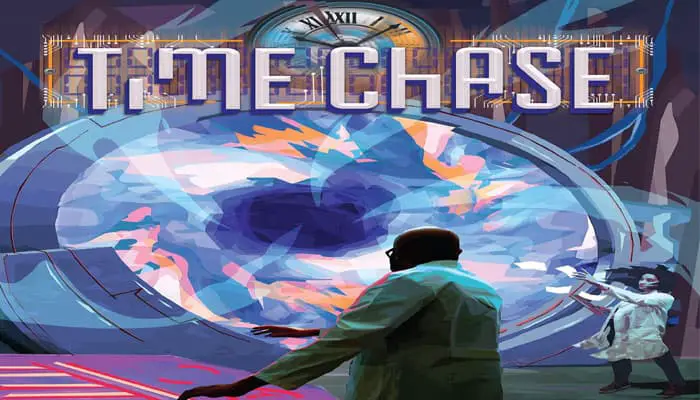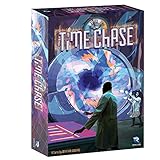
Components

- 65 Element Cards
- 18 Control Discs
- 10 Event Tokens
- 6 Traveler Pawns
- 30 Fuel Crystals
- 6 Time Machine Cards
- 1 First Player Marker
- 1 Rulebook
Element Card Suits
The various cards in the element deck are divided into five suits. Each suit represents an important element in the discovery of time travel.

Setup
Important: Before the game, you will need to remove certain cards from the element deck, based on the number of players in the game. Consult the chart below to determine which cards to remove. Return the removed cards to the game box; they will not be used.
| Players | Cards to remove | Deck size |
|---|---|---|
| 6 | none | 65 cards |
| 5 | 1 and 2 of each suit | 55 cards |
| 4 | 1, 2, 3, and 4 of each suit | 45 cards |
| 3 | 1, 2, 3, 4, 5, and 6 of each suit | 35 cards |

1 Choose one player as the dealer, who shuffles the element deck and deals each player a hand of ten cards.
2 Place the remainder of the element deck off to the side of the play area.
3 Reveal the top card of the element deck. Rotate it sideways and tuck it partially beneath the deck, so that the card's suit remains visible.
4 Stack the event tokens in ascending numerical order (i.e., "1" on the top and "10" on the bottom). Place this stack off to the side of the play area.
5 Take the "1" event token from the stack and place it next to the element deck.
6 Each player takes a time machine card in the color of their choice, placing it with side A (standard mode) or side B (time jumble mode) face up.
7 Each player takes a set of three control discs in the color of their choice and places them in the three slots on their time machine card.
(}} Each player takes a traveler pawn in the color of their choice and places it next to the "1" event token.
9 Place the fuel crystals off to the side of the play area to form the general supply.
10 Give the first player marker to the player seated to the left of the dealer.
Intro to Time Travel
"Some people say that history abhors a paradox. This is most vehemently not so. If you asked it, history would simply shrug its shoulders like an angsty teenager. 'Whatever.' History does a stellar job of ignoring paradoxes. History, however, still hates Mondays". -Garfield
The Timeline
During each round of the game, a new event token is added to the end of the growing row of event tokens, forming a linear timeline of consecutive events.
The newest event token in the timeline is known as the present. Any player whose traveler is located at this event is considered to be "in the present".
All previous event tokens in the timeline are collectively known as the past. Any player whose traveler is located at a previous event in the timeline is considered to be "in the past".

The Invariant
The face-up card beneath the element deck is known as the invariant. This card's suit indicates the most powerful suit. When an event is resolved during the game, the highest played card of this suit is the winning card, and that player gains control of the event.
However, the invariant can be altered if someone travels far enough back in time and swaps it out for a card of a different suit.
The Travelers
Each player has their own traveler pawn, whose position represents their current location in the timeline. Players can only participate in the event at their traveler's current location.
At the start of the game, all travelers are in the present. When a new event token is added to the timeline, all travelers immediately return to the present.
At the end of each round, players can spend fuel to move backward in the timeline, so that they can potentially change the outcome of previous events.

Game Play
A game of Time Chase is played in a series of rounds. During each round, there are three steps that occur in order:
- Resolve Events
- Time Passes
- Move Travelers

1. Resolve Events
All events where travelers are located resolve, one at a time. Start with the event in the present and work backward in the timeline through all of the events in the past, ending with the invariant back at the very beginning of the timeline.
When an event resolves, all players whose travelers are located at that event in the timeline must participate.
Determining Who Leads
The player who controls the previous event in the timeline has the lead. If that player is not participating because their traveler is located elsewhere in the timeline, then the participating player closest to them in clockwise order has the lead.
Important! When resolving the first event in the timeline, since there is no previous event, the player holding the first player marker (or the closest participating player) has the lead instead.
 Determining Lead from Previous Event |
Playing Cards
The player who has the lead plays a card from their hand. In clockwise order, each other participating player plays a card from their hand. If possible, each player must follow suit by playing a card of the suit that was led. If a player has no cards of the led suit, they may instead play a card of any suit.
Important: When playing cards to an event in the past, all participating players - including the player who currently has the lead - must still follow the suit that was originally led!
When it is their turn, if a player follows suit but their card is lower than the current highest card of the led suit, they immediately gain one bonus fuel from the general supply, which they should keep next to their time machine card.
 Gaining Bonus Fuel |
Resolving the Outcome
After all cards have been played, determine the winning card. Normally, the highest card of the led suit is the winning card. However, if any cards of the invariant suit were played, then the highest card of the invariant suit is the winning card.
-
In The Present...
Create a stack with the led card (on bottom) and the winning card (on top), oriented so that the suits and values of both cards remain visible, and place it below the event token. If the led card is the winning card, place it by itself. Discard all other played cards.

-
In the Past.
If any of the new cards beat the old winning card, remove the old winning card from the stack and replace it with the new winning card, then discard the old winning card and all other played cards. Do not discard the originally led card, however.

Whoever played the winning card gains control of the event. That player takes the rightmost control disc from their time machine card and places it on top of the event token.
Important: When a player gains control of an event in the past, the control disc that was there previously is removed and returned to its owner.
Altering the Invariant
Despite what its name may suggest, the invariant can be altered, but only if one or more players send their travelers all the way back to the very beginning of the timeline. This occurs after all other events in the timeline have been resolved.
Each player whose traveler is located at the invariant secretly chooses a card from their hand, then all players simultaneously reveal their chosen cards. The highest card becomes the new invariant card and the old invariant card is discarded, along with all other played cards.
Important: If there is a tie for highest card, then no card becomes the new invariant card, but the old invariant card is still discarded, along with all played cards.
When this happens, the timeline is unstable! There is no invariant for now.
 Altering the Invariant |
2. Time Passes
Take the top event token from the stack and place it at the end of the timeline, next to the previous event token, so that all event tokens in the timeline are in numerical order. This newly placed event token is now considered to be "the present".
All travelers move from their current locations in the timeline and return to the present, next to this newly placed event token.
All players gain fuel from the general supply, which they should keep next to their time machine card. Each player gains two fuel by default, minus one fuel for each of their control discs that is currently in the timeline.
 Returning to the Present |
3. Move Travelers
Players may - but are not required to - spend fuel in order to move their travelers backward in the timeline, so that they can attempt to change the outcome of previous events.
Each player uses one hand to shield their time machine card and personal fuel supply from the view of their opponents, then secretly chooses how much fuel they wish to spend, placing that much fuel from their personal supply onto their time machine card.
When all players have done this, the players simultaneously reveal how much fuel they are spending. Each player returns their spent fuel to the general supply, then moves their traveler backward in the timeline, one space for every fuel they spent.
 Revealing Spent Fuel |
End of the Game
After resolving all events each round, check to see if the end of the game has been reached. The game ends when one player controls three events in the timeline or when ten rounds have been played - whichever happens first.
If one player controls three events in the timeline, that player wins!
If multiple players each control three events, the tied player who controls an event closest to the invariant in the timeline wins.
If ten rounds have been played and still nobody controls three events in the timeline, compare all players who control two events in the timeline. The tied player who controls an event closest to the invariant in the timeline wins.
(This can only happen in a 5- or 6-player game).
Continue Reading
